2.10 till 12.10.2015, 10 days, currency rate 1 € = 2.4 F$ (Fijian dolar)
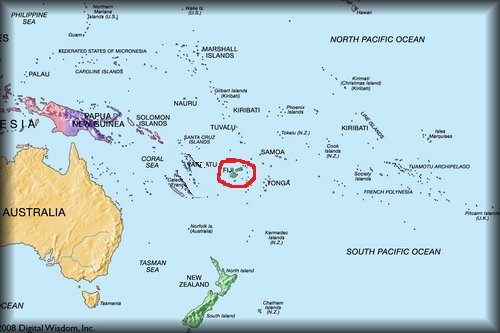
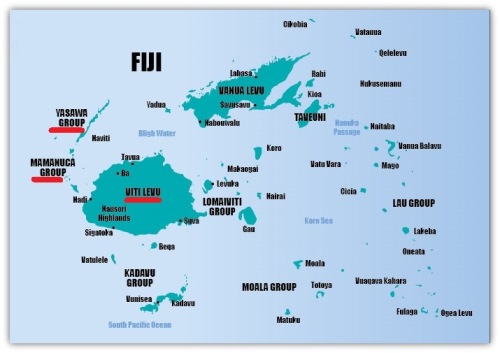
Introduction
 I love the Pacific Islands, mainly because of the climate and the people. And it does not matter to me where I am, whether in Polynesia, or as in this case, in Melanesia. All the time I could hear "Bula", what is usually accompanied by a broad smile and openness - the attitude of the locals.
I love the Pacific Islands, mainly because of the climate and the people. And it does not matter to me where I am, whether in Polynesia, or as in this case, in Melanesia. All the time I could hear "Bula", what is usually accompanied by a broad smile and openness - the attitude of the locals.
However I can’t forget that islanders live here, who did not accept the Western lifestyle. Still there is a concept called "Fiji time", that is generally speaking, go with the flow, forget about the watch. Why hurry when the sun and palm trees are next to you, life in slow motion. And I love that pace.
The surprise for many might be a large number of Indians living in Fiji. There are some sources providing their population close to the half of total inhabitants on the country. They usually inhabit the coast of larger islands, you rarely meet them inside those islands, or other tiny paradise islands.
![]()
Viti Levu Island
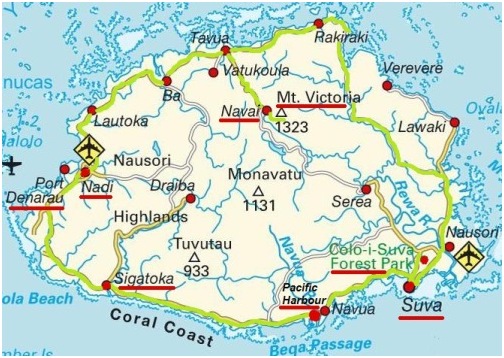
I know from experience that the main islands of the Pacific archipelagos are usually the least interesting. Too touristy, but too little exotic, and the locals have also slightly changed their attitude towards tourists. Flights to more isolated islands of Fiji were too expensive, and to travel by ferry I didn’t have enough time. So I stayed on the main island of Viti Levu (and it was a mistake).
Our trip also included a Sunday, and I read that during Sundays the daily life on the island dies - mainly due to lack of transport. Therefore, I decided to rent a car - an expensive option, but taking with me my wife, mother and nearly one year old baby, I thought that it would be easiest way.
- an expensive option, but taking with me my wife, mother and nearly one year old baby, I thought that it would be easiest way.
Nadi airport we left inside the rented car. The map which we had received at the airport was very basic, no much details, so driving at night delivered us a lot of problems, especially with hotel location. However, in the end with some help of the locals we reached our destination.
Nadi is not a best place to spend the time on the island. The only advantage is the international airport. Hotels and backpackers are located around 7 km south of the airport, close to the black volcanic beach – however rubbish doesn’t encourage to sunbathing or swimming. The city center is an additional 5-minute drive south – pollution, traffic, nothing interesting. The only object worth of attention is the Hindu Temple of Sri Siva Subramaniya. However, as someone has already traveled through Asia, it can be skipped.
The next morning we went on a tour around the island in the clockwise direction. Lautoka is an industrial city, but further on began increasingly pleasant villages. There strolling through the market already brought interesting and warm contacts with the locals. We bought a root "yaquona", which is used for making ceremonial "kava". We were going into the interior of the island and planned to use it.
Car hardly climbed the rocky road 800 meters above sea level. There were many turns, quite steep, it seemed that the car won’t make it. However we moved on. When after 20 kilometers we reached the Nadarivatu Pass, where there was a local hospital, we left the car there and continued on foot.
We were hiking and every encountered car stopped and asked how it can help. After an hour of walking we reached the Nadrau village, 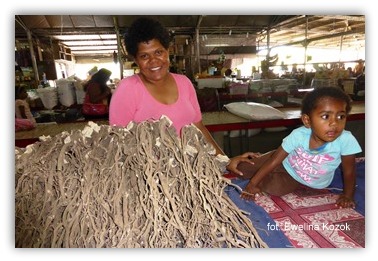 where we were invited to stay at the first house. However we went further, to the person who had previously met us along the way and invited to his place, it turned out to be a relative of the village chief. We were pleasantly welcomed, we got their own room and bathroom.
where we were invited to stay at the first house. However we went further, to the person who had previously met us along the way and invited to his place, it turned out to be a relative of the village chief. We were pleasantly welcomed, we got their own room and bathroom.
Before the trip I’ve read that I should give the yaquona to the village chief. It’s a root from which the locals make liquor "kava", which then we drink together during the ceremony. Well, Viti Levu is probably not the best place for such occasions - the village was all made of concrete or corrugated iron, chief was dressed in a European style with his 4WD. He took the root, and that was that. In fact, even worse, because they did not take it as a gift, as the second day he suggested that we supposed to leave a tip - simply pay for the night. It was a little disappointing, but maybe my expectations were too high – there are no longer traditional villages in Viti Levu, at least no near the road (with one exception village of Naval, but there you have to pay an entrance fee and photographing permit, so it’s like the museum and it’s outside my range of interests).
Despite this, I loved staying in the village, the people were nice, the surrounding nature beauty, the perfect climate. The next day was Sunday, so we witnessed an interesting folklore in the church. My plan was also climbing the highest peak in the country - Mount Tomanivi 1324m. I was in hurry, so I left my family behind and I hired a local guide to led me there. I like walking in the mountains alone, so it was hard to decide on a guide, but with no maps and wanting to save some time, I opted for guided version.
 We started at 7 am, and as it turned out, the guide took with him his brother and a machete.
We started at 7 am, and as it turned out, the guide took with him his brother and a machete.
What he needs the machete for? - I thought.
It started badly as we were negotiating already determined price for the service - I hate this approach. Later we made a shortcut which apparently supposed to save me a lot of distance between the villages, however it did not look for more than 15 minutes time gained. When we came to the Navai village, my guides were asking the boys playing football for instructions. Once, twice, three times. They explained to me that there are two alternative routes to the summit and were asking about the potential path condition. I didn’t believe it. In the end, they decided to enter into a cornfield, and then into the woods. They got lost, turned back, repeat the scenario all again. Comedy reached its peak when one of them pulled out a mobile phone and called another brother for directions (as apparently the brother was a professional guide). In total, the play lasted nearly an hour and I realised that when the mobile battery get completely drained, or the credit run out, the adventure is over. In a meantime they entertained me with collecting the grapefruit and asking the questions about everything except today's tour. On one hand I was angry on them (as it turned out they haven’t been on the summit in the last 15 years), on the other hand I thought I was lucky I haven’t decided to climb alone.
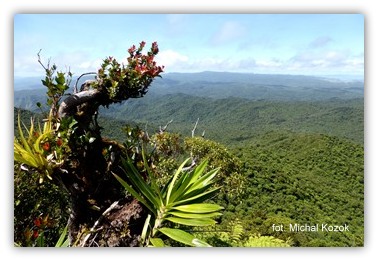 Suddenly after one call breakpoint came – we returned south and after a while we entered a wide clear path. The path climbed straight to the top - literally straight, which meant we were gaining up 100 meters altitude every 10 minutes hike, in the form of a nearly vertical climb with four limbs. If it was after the rain, it wouldn’t be fun. In the end, I stopped waiting for the brothers and their dog, and we agreed that they catch up with me on the summit, where shortly I was admiring a vast panorama. They also arrived and we relaxed, took some photos, talked, and started descending. Without being lost we quickly reached the first village’s buildings - and here a surprise - the guides did not want to go on the path anymore, because as it turned out, we would have to pay an entrance fee (reportedly 30 F$, 12 €). So again we struggled through some fences, fields, bushes, in order to detour some of the houses. Next, the road back to our village was very easy, so I paid a total of 30 F$ for both guides (initially we agreed on 20 F$), and I ran to Nadrau to see the Sunday mass. I still was on time as it lasted a few hours – I was relief for my family and good pretext to finally get out of there.
Suddenly after one call breakpoint came – we returned south and after a while we entered a wide clear path. The path climbed straight to the top - literally straight, which meant we were gaining up 100 meters altitude every 10 minutes hike, in the form of a nearly vertical climb with four limbs. If it was after the rain, it wouldn’t be fun. In the end, I stopped waiting for the brothers and their dog, and we agreed that they catch up with me on the summit, where shortly I was admiring a vast panorama. They also arrived and we relaxed, took some photos, talked, and started descending. Without being lost we quickly reached the first village’s buildings - and here a surprise - the guides did not want to go on the path anymore, because as it turned out, we would have to pay an entrance fee (reportedly 30 F$, 12 €). So again we struggled through some fences, fields, bushes, in order to detour some of the houses. Next, the road back to our village was very easy, so I paid a total of 30 F$ for both guides (initially we agreed on 20 F$), and I ran to Nadrau to see the Sunday mass. I still was on time as it lasted a few hours – I was relief for my family and good pretext to finally get out of there.
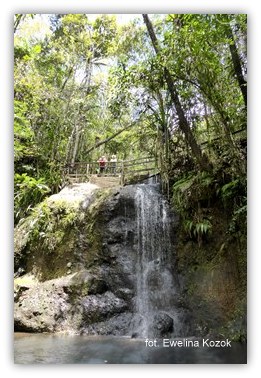 From the village we went back to the car, this time 5 km uphill. It was Sunday, but there was traffic in both directions, not only privet cars but even public transportation! In the end, we jumped to one of the pick-ups and get the lift to the hospital. An hour later we were at the sea shore. However nothing interesting stopped us on the coast and surprisingly we were in the capital the same evening. In Pacific perspective Suva is a big town, we get lost a bit but finally found a budget hotel. Although before leaving Australia most of the people warned us of night walks in the Fiji towns, the locals saw no justification for such reasoning. It seems that it is safe there.
From the village we went back to the car, this time 5 km uphill. It was Sunday, but there was traffic in both directions, not only privet cars but even public transportation! In the end, we jumped to one of the pick-ups and get the lift to the hospital. An hour later we were at the sea shore. However nothing interesting stopped us on the coast and surprisingly we were in the capital the same evening. In Pacific perspective Suva is a big town, we get lost a bit but finally found a budget hotel. Although before leaving Australia most of the people warned us of night walks in the Fiji towns, the locals saw no justification for such reasoning. It seems that it is safe there.
In Suva I recommend to see the market, which everywhere on the island is always colorful, inexpensive and interesting. Although can be seen in any other village. Apart from the promenade we did not find anything interesting in the capital. But just a few kilometers north of the city center is a national park Colo-I-Suva Forest (admission 5 F$, 2 €). It is a jungle with paths, lagoons and waterfalls, but there are also human made infrastructure in the form of stairs, fences and marked trails. There are several variations of pleasant walk, from short to long. Because Fiji has not life-threatening human predators, swimming in the numerous lagoons is pleasantly recommended. Locals show the skills jumping from swing rope
 However, my main target on theViti Levu was in Pacific Harbour, Coral Coast. Here I was going to make the world famous shark dive. Photos strongly encourage doing it – an impressive view of a group of divers sitting on the sandy seabed in turquoise water among a huge. Unfortunately, the global fame didn’t help me - both diving operating companies were already fully booked for the next few days. With little hope I waited until morning for last minute cancellations, but unfortunately nothing changed. Diving with sharks didn’t work for me, bad luck :( The cost of such attraction is 245 F$ (102 €) for a single and 325 F$ (135 €) for two dives, plus equipment rental fees, entry to the park etc. about 125 F$ (52 €). Diving with sharks is also organised on other islands, but the reviews didn’t look as attractive as here.
However, my main target on theViti Levu was in Pacific Harbour, Coral Coast. Here I was going to make the world famous shark dive. Photos strongly encourage doing it – an impressive view of a group of divers sitting on the sandy seabed in turquoise water among a huge. Unfortunately, the global fame didn’t help me - both diving operating companies were already fully booked for the next few days. With little hope I waited until morning for last minute cancellations, but unfortunately nothing changed. Diving with sharks didn’t work for me, bad luck :( The cost of such attraction is 245 F$ (102 €) for a single and 325 F$ (135 €) for two dives, plus equipment rental fees, entry to the park etc. about 125 F$ (52 €). Diving with sharks is also organised on other islands, but the reviews didn’t look as attractive as here.
The last more interesting attraction (in our opinion) on the route back to Nadi is Sigatoka Sand Dunes National Park. Admission to the park is 10 F$ (4 €) - we were given a map with several trails options from a short 30 minutes ones to up to 2 hours. Compared to the jungle, walking here comes in the open space, no tree’s shade to protect from the heat. The sand burned our feet. But the park is even pleasant, interesting dunes and right next to the ocean. On the beach shelters made from branches are constructed, giving perfect escape from the sun and wind.
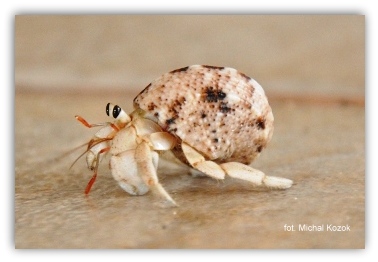 Hence, short journey back to Nadi (60 km) remained, where we left the car at the airport. The car was the travel comfort, but certainly not essential. However we could pick up local hitchhikers. This allowed us making some closer contact and interesting conversations. And of course, we could stop whenever we desired. The island was nice, but after compering other islands, I can say that don’t waste too much time on Viti Levu.
Hence, short journey back to Nadi (60 km) remained, where we left the car at the airport. The car was the travel comfort, but certainly not essential. However we could pick up local hitchhikers. This allowed us making some closer contact and interesting conversations. And of course, we could stop whenever we desired. The island was nice, but after compering other islands, I can say that don’t waste too much time on Viti Levu.
Own car may give the easiest way to move around, but certainly we lost the unique atmosphere of travelling by public transport. In any case, if you decide to explore the main island, do it at the very beginning of the journey, otherwise you will be comparing the previous experiences, and those of the other islands should be much stronger.
![]()
Mamanuca and Yasawa Archipelago

If you want to know how paradise looks like, come here - I heard such a feedback from other people and I have to admit that they weren’t far from the truth. Even I, the person who doesn’t like beaches much, 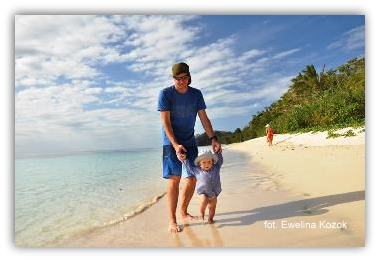 I have to say that if your plan is relax, the volcanic islands of Mamanuca and Yasawa are perfectly suitable for this reason. There's no doubt - these islands are beautiful.
I have to say that if your plan is relax, the volcanic islands of Mamanuca and Yasawa are perfectly suitable for this reason. There's no doubt - these islands are beautiful.
I opted for an express version, as it’s my style - that means to see as much as possible in a short time. Of course I wanted to see both archipelagos, because Mamanuca are mostly rather small and flat islands, some of them can be walked around within five minutes. While the Yasawa is completely different with high rocky hills as a part of the landscape.
Worldwide audience may already be familiar with those islands from the movie "Blue Lagoon", filmed at Turtle Island at Yasawa and Cast Away, filmed on Monuriki at Mamanuca.
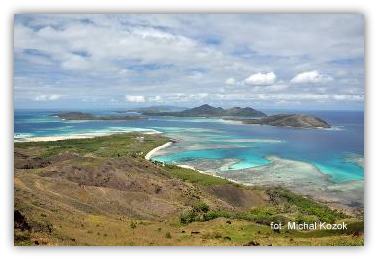 We can get to these islands from Denarau Harbour, where large catamaran motor vessel departs. It’s operating under the name of the company Awesome Adventures Fiji. The ticket includes return transfer between the harbour and your hotel in Nadi. It is an expensive trip, but seaplane flights are even more expensive. The last alternative is to have your own yacht.
We can get to these islands from Denarau Harbour, where large catamaran motor vessel departs. It’s operating under the name of the company Awesome Adventures Fiji. The ticket includes return transfer between the harbour and your hotel in Nadi. It is an expensive trip, but seaplane flights are even more expensive. The last alternative is to have your own yacht.
You can buy a return ticket to one of the chosen island, but if you are going to spend around 1-3 nights on a few islands, the cheaper option is to purchase the pass. The shortest one is 5-day option, which means that maximum four nights can be spent on any of the selected islands. After detailed research I decided on two islands in the Yasawa (Drawaqa and Nacula) and one at the Mamanuca (Bounty Island).
Yasawa Archipelago
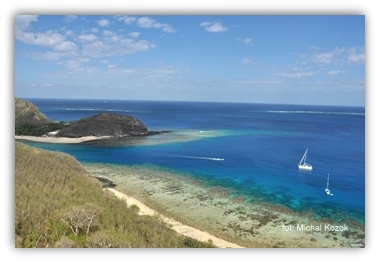 One of my main reasons to go to Fiji was wishing to see the huge manta rays. So the ideal choice became Manta Barefoot Resort on the Drawaqa Island. Cottages, called here Bure, are located on a sandy peninsula, where on the one hand we have the sunrise beach, three minutes walking away is the sunset beach, and between them we have yet another beautiful beach. Simple wooden bures are located right on the ocean shore. Activities schedule is written on the board, so except sunbathing or snorkeling (I suggest you take with you your own equipment), we have the options of professional diving (150 F$ (62 €) for one, 235 F$ (98 €) for two dives), rental of water equipment (kayak, tube), abseiling, local plant’s medicine or jewelry making lessons, play volleyball, etc. Besides, meetings, ceremonies, games and fun for all are also frequently organised.
One of my main reasons to go to Fiji was wishing to see the huge manta rays. So the ideal choice became Manta Barefoot Resort on the Drawaqa Island. Cottages, called here Bure, are located on a sandy peninsula, where on the one hand we have the sunrise beach, three minutes walking away is the sunset beach, and between them we have yet another beautiful beach. Simple wooden bures are located right on the ocean shore. Activities schedule is written on the board, so except sunbathing or snorkeling (I suggest you take with you your own equipment), we have the options of professional diving (150 F$ (62 €) for one, 235 F$ (98 €) for two dives), rental of water equipment (kayak, tube), abseiling, local plant’s medicine or jewelry making lessons, play volleyball, etc. Besides, meetings, ceremonies, games and fun for all are also frequently organised.
On the island besides watching the rising or setting sun, you can also take a 20-minute hike to the top of the hill, which offers a wonderful panorama.
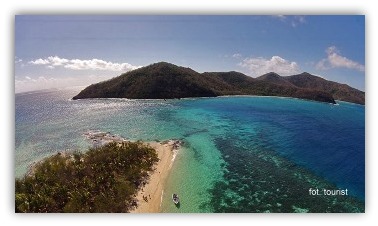
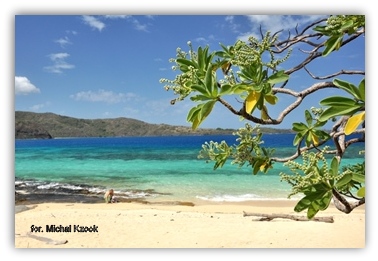
Self-service breakfast is served in the main building in the middle of the complex. Lunch and dinner are served on the rocky beach - the atmosphere is unique - sun, sea breeze, romantic lighting, burning fireplace, delicious food, refreshing drinks.
Snorkelling with Manta Rays is the most famous attraction (also available from several neighboring resorts). Mantas arrive for mating between the islands of Drawaqa and Naviti, roughly from May till October. We might have a chance to see the female and following her males. Unfortunately, there is no guarantee, because the rays only appear when the appropriate sea conditions occur. It seems that a little more than half of the tourists were lucky to see them alive.
 When the mantas are showing up in the area, an alarm is raised on the island and interested in show tourists jump on the boat (35 F$, 15 €). Holding fins, mask and snorkel we are ready for short motorboat ride to the specific place. There we just have to spot these amazing animals, then we could swim with them (we share the spectacle along with crowd of other tourists). I took short fins with me (definitely recommend the long one) and was swimming against the current - I wasn’t able to keep the pace with rays - after a few minutes I was pumped out and lost them from sight. Fortunately, after boat relocation I saw them again - this is an unforgettable view. They look like space ships in slow motion soaring through the air. Huge, moving gracefully just below the surface of the turquoise water. Revelation.
When the mantas are showing up in the area, an alarm is raised on the island and interested in show tourists jump on the boat (35 F$, 15 €). Holding fins, mask and snorkel we are ready for short motorboat ride to the specific place. There we just have to spot these amazing animals, then we could swim with them (we share the spectacle along with crowd of other tourists). I took short fins with me (definitely recommend the long one) and was swimming against the current - I wasn’t able to keep the pace with rays - after a few minutes I was pumped out and lost them from sight. Fortunately, after boat relocation I saw them again - this is an unforgettable view. They look like space ships in slow motion soaring through the air. Huge, moving gracefully just below the surface of the turquoise water. Revelation.
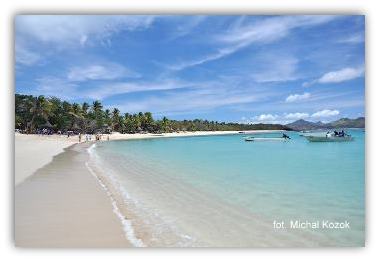 The second island I visited was Nacula. There are several resorts located, and on the western shore two of them - Blue Lagoon Resort and Oarsmans Bay Lodge. The first is owned by New Zealander and the other one is running by the local village. They are right next to each other, so while walking on the beach is even hard to notice the border between the resorts. The quality of events and activities in the first one is much higher, but we decided on local attractions. One of the reasons was also the fact that Oarsmans is the only resort on the archipelago that offers camping. You can bring your own tent or the locals will set up one for you straight on the beach – we opted for this option. Not only that was cheaper than in a house, in addition, next to the ocean.
The second island I visited was Nacula. There are several resorts located, and on the western shore two of them - Blue Lagoon Resort and Oarsmans Bay Lodge. The first is owned by New Zealander and the other one is running by the local village. They are right next to each other, so while walking on the beach is even hard to notice the border between the resorts. The quality of events and activities in the first one is much higher, but we decided on local attractions. One of the reasons was also the fact that Oarsmans is the only resort on the archipelago that offers camping. You can bring your own tent or the locals will set up one for you straight on the beach – we opted for this option. Not only that was cheaper than in a house, in addition, next to the ocean.
When we got to the resort, we found out that we were the only guests. Nevertheless, we felt so welcome. The locals were too lazy to set up the tent for one night, so they offered us a house right on the ocean. Beautiful long beach, wonderful water, and even more beautiful coral reef - all within a few steps from the bure! I have to admit that the reef over here was the prettiest of all I’ve seen in Fiji.

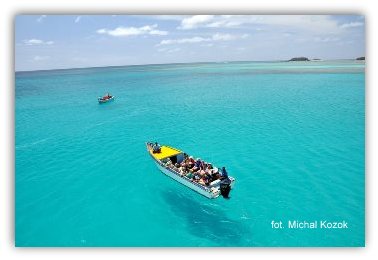
Popular resort’s attraction is the trip to Blue Lagoon (the nearby bay, not to be confused with Blue Lagoon Resort, which is not located next to Blue Lagoon bay), where the famous movie of the same name (Blue Lagoon) was filmed. Another popular trip is the ride to the caves Sawa-I-Lau, where you can take a boat inside the rocks lit by scattered sun rays, or dive under into hidden dark rock chambers. The prices of these depend on the amount of people, but you should expect a cost of 30-50 F$ (12-20 €) per person. A sunset cruise costs 20 F$ (8 €) per person, and in the offer is also a free trip to a local village. We used service of relaxing massage on the beach (40 F$, 16 € per hour), and we saw how the locals organise crab racing (free). There are offered a few more activity options, however, dependent on the number of participants and weather conditions.
 As the next day was Fiji Independence Day (10 October), we were witnessing village gathering with national anthem singing. Great folklore. Then the locals arranged the ceremony of preparing and drinking “kava”, which we also were invited. Normally such ceremonies are organized for tourists by the resorts, but here we have a local celebration. “Kava” is a drink brewed from the root of yaquona, after which our tongue get numb, and if the drink is sufficiently strong, it can even shake your head similar way as alcohol does. The first bowl of kava is passed to the chief of the village, and then followed by the master of ceremony and guest, in this case me. After all other males were allowed continue drinking “kava”. However, according to the tradition the drink wasn’t offered to the women who accompanied me. When we finally left, the locals continued enjoying themselves with the music accompaniment from the stereo, and played their guitars and other wooden instruments. And I must admit that they sing nicely.
As the next day was Fiji Independence Day (10 October), we were witnessing village gathering with national anthem singing. Great folklore. Then the locals arranged the ceremony of preparing and drinking “kava”, which we also were invited. Normally such ceremonies are organized for tourists by the resorts, but here we have a local celebration. “Kava” is a drink brewed from the root of yaquona, after which our tongue get numb, and if the drink is sufficiently strong, it can even shake your head similar way as alcohol does. The first bowl of kava is passed to the chief of the village, and then followed by the master of ceremony and guest, in this case me. After all other males were allowed continue drinking “kava”. However, according to the tradition the drink wasn’t offered to the women who accompanied me. When we finally left, the locals continued enjoying themselves with the music accompaniment from the stereo, and played their guitars and other wooden instruments. And I must admit that they sing nicely.
An additional attraction of the island is its hilly region. It allowed me to climb and enjoy the views from the top, our island and the surrounding bays and parts of the archipelago. Due to the upcoming clouds, I had to climb the neighboring hills twice to finally shoot the picture at the right sunlight.
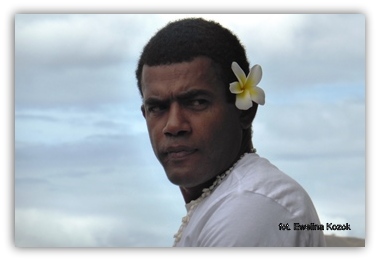
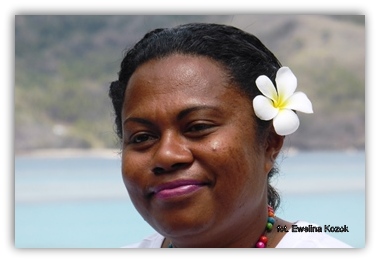
On Yasawa I was considering also to visit the island of Kuata, but eventually gave up due to time shortage. Kuata is characterised by organising shark dives. They are not quite as attractive as those in Pacific Harbour because of the size of the sharks, but it is certainly an attraction worth recommending.
Mamanuca Archipelago
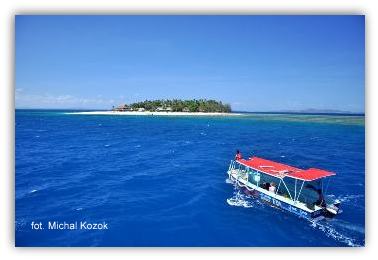 The next day we sailed to our last island, Bounty. Here, however, the trip had an unexpected situation. The third day in a row the motorboat broke down during the cruise, so in addition to the several hours delay (although at least during the breakdown the staff set us off on Turtle Island, the real Blue Lagoon, where we could explore new landscape), on the way back one of the engines broke down again. When the crew called us to disembark big boat to a small one, we already faced a storm in complete darkness. The problem was that at such high waves of the difference in levels between decks ranged sometimes up to 150cm, and from time to time boats moved away from each other creating a gap big enough to fall into, which most likely would end up with crushing the human body by boats mass. It was evident that the crew didn’t care of basic safety procedures and even didn’t provide us the requested life jackets. However, we managed to board the vessel, but our infant sensed the danger and screamed
The next day we sailed to our last island, Bounty. Here, however, the trip had an unexpected situation. The third day in a row the motorboat broke down during the cruise, so in addition to the several hours delay (although at least during the breakdown the staff set us off on Turtle Island, the real Blue Lagoon, where we could explore new landscape), on the way back one of the engines broke down again. When the crew called us to disembark big boat to a small one, we already faced a storm in complete darkness. The problem was that at such high waves of the difference in levels between decks ranged sometimes up to 150cm, and from time to time boats moved away from each other creating a gap big enough to fall into, which most likely would end up with crushing the human body by boats mass. It was evident that the crew didn’t care of basic safety procedures and even didn’t provide us the requested life jackets. However, we managed to board the vessel, but our infant sensed the danger and screamed  all the way, while the powerful waves rocked us. We even couldn’t change the position on the small boat, as we had to hold to metal railings preventing us from falling away, all horror last around half an hour. But the worst was that the crew changed the landing order and firstly arrived with young backpackers to South Sea Island. This meant that we had to change the boat again and sail to the Bounty - luckily for us, this time surfing with the waves, so the crossing wasn’t as bad as the previous one.
all the way, while the powerful waves rocked us. We even couldn’t change the position on the small boat, as we had to hold to metal railings preventing us from falling away, all horror last around half an hour. But the worst was that the crew changed the landing order and firstly arrived with young backpackers to South Sea Island. This meant that we had to change the boat again and sail to the Bounty - luckily for us, this time surfing with the waves, so the crossing wasn’t as bad as the previous one.
Bounty Island Resort welcomed us with warm drinks and delicious dinner. On the occasion of Fiji Independence Day, it wasn’t ordinary dinner – the tables struggled to support all dishes. After the meal the time came for the kava ceremony, and this time each visitor was able to taste the bitter drink. And then the fun came - the artistic show presented by the resort staff. Generally, professional dances for tourists bore me - but these, as performed by amateurs, were hilarious. I could see that guys tried their best with a lot of joy and fun.
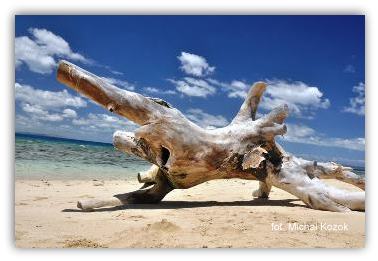 Bounty Island is flat like a pancake, sandy and tiny. We walked around the island in half an hour. After returning I went for a massage (60 F$, 25 €, but wife looked after pretty Fijian masseuse :) I played table tennis with locals and drank sweet drinks on the beach, and played with a happy little boy in the pool (too big waves in the ocean).
Bounty Island is flat like a pancake, sandy and tiny. We walked around the island in half an hour. After returning I went for a massage (60 F$, 25 €, but wife looked after pretty Fijian masseuse :) I played table tennis with locals and drank sweet drinks on the beach, and played with a happy little boy in the pool (too big waves in the ocean).
After five days we had to say goodbye to the paradise islands and we returned to the Denarau at the evening, and hence straight to Nadi.
On Mamanuca I wanted to stay on the smallest possible flat sandy island. The ideal candidate seemed to be a South Sea Island or Beachcomber, but the first island does not offer private rooms (only dorms from 15 years old) and the other is famous for its great backpacker parties, so staying there with the child was inadvisable. Generally these islands are place for a party with developed wide range of water sports activities. South Sea Island is also close to Viti Levu, so there are organized half or full day excursions from the main island, at a cost of 200 F$ (83 €).
![]()
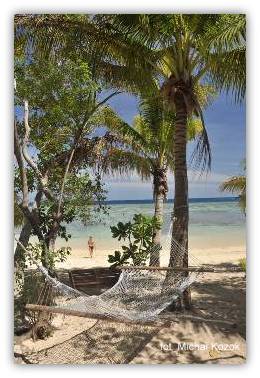 accommodation – As we had a child, we did not have the option to use the dormitory (with one exception). I do, however, provide different options for you.
accommodation – As we had a child, we did not have the option to use the dormitory (with one exception). I do, however, provide different options for you.
Nadi – Wailoaloa Beach Resort. Price 85 F$ (35 €) for 3 adults and infant. Dormitory costs 22 F$ (9 €). Breakfast and airport transfers are included, there is swimming pool, parking, wifi, TV (AC extra 10 F$, 4 €). Very nice, quiet, friendly service, affordable and delicious evening meals, same with the drinks by the pool. It’s true that the resort is 1km away from the sea, but honestly - in Nadi there is no need to be on the beach. Our friends recommended the nearby Oasis Palms Hotel, where the official price for the dormitory is 38 F$ (16 €) per person (also included airport transfers, welcome drinks, wifi, breakfast)
Suva – we arrived at night, so searching the cheap hotel in darkness was difficult. It was not until the fourth accidentally encountered hotel, called Townhouse Apartment Hotel had affordable prices - for room for three adults we paid 90 F$ (37 €).
Pacific Harbour – shark diving causing the popularity in this place. We found good enough conditions in Tsulu Backpackers, and as we were there the only ones willing to stay at dormitory, we were allowed to use this option with the child. We paid 30 F$ (12 €) per person.
Mamanuca and Yassawa Archipelagos.
Barefoot Manta Resort - Dormitory cost from 51 F$ (21 €), standard bure (cottage) 105 F$ (44 €) per person if two are staying (single person pays double), 89 F$ (37 €) per person if three are staying, luxory bure 172 F$ (71 €) per person if two are staying, 111 F$ (46 €) per person if three are staying.
You have to purchase accommodation together with full board meals, which costs 85 F$ (35 €) per person per day (breakfast, lunch, dinner).
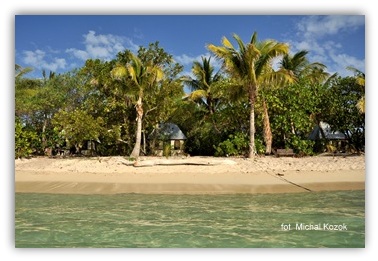 Oarsmans Bay Lodge -
camping 90 F$ (37 €) for family tent up to 6 persons if you are using their equipment, dormitory 50 F$ (21 €) per person, bure (cottage) from 230 F$ to 460 F$ (96 € to 192 €) per bure, depends on location and number of people.
Oarsmans Bay Lodge -
camping 90 F$ (37 €) for family tent up to 6 persons if you are using their equipment, dormitory 50 F$ (21 €) per person, bure (cottage) from 230 F$ to 460 F$ (96 € to 192 €) per bure, depends on location and number of people.
You are required to purchase it together with full board meals, which cost 89 F$ (37 €) per day (breakfast, lunch, dinner).
Bounty Island - Dormitory 47 F$ (19 €), standard bure (cottage) 145 F$ (60 €) for max two persons, or 175 F$ (73 €) for max two persons and two children.
You have to purchase accommodation together with full board meals, which costs 85 F$ (35 €) per person per day (breakfast, lunch, dinner).
Dormitory is the only option In South Sea Island. So you can’t stay there with children under 15 years old (kids are allowed only on day trips), which majority of backpackers are happy about. Beachcomber Island is also recognised a party-island.
![]()
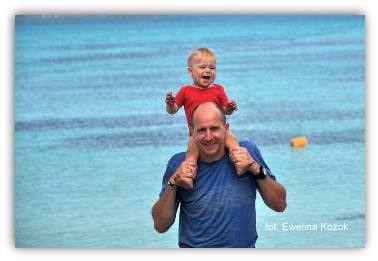 transport – car rental is quite expensive. If not baby in the team, I wouldn't decide for that option. I paid 500 F$ (42 €/day) for 5 days, plus petrol consumption while driving around the island and one trip to interior (550 km), costs me around 80 F$ (33 €), plus baby seat 40 F$ (16 €). Total 620 F$ (258 €).
transport – car rental is quite expensive. If not baby in the team, I wouldn't decide for that option. I paid 500 F$ (42 €/day) for 5 days, plus petrol consumption while driving around the island and one trip to interior (550 km), costs me around 80 F$ (33 €), plus baby seat 40 F$ (16 €). Total 620 F$ (258 €).
Getting from the airoprt – most resorts have included in price return airport transfers (except the late night flights). Backpackers version - get out from the terminal and proceed to the main road where buses are heading to Nadi, get off in hotel area - price 1 F$ (0.4 €).
Getting to the islands is organised by Awesome Adventures Fiji. You can buy single ticket from point A to B, but if you would like to explore more in short time, pass will be the cheaper option. I decided on the shortest possible pass – just 5 days. This means that it is valid for five consecutive days from the date of the first ride. This allowed me to spend 4 nights at 3 islands, using four routes below:
Port Denarau – Barefoot Manta 8.30am - 11.30am (3 hours cruise)
Barefoot Manta – Oarsmans Bay Lodge 11.30am – 1pm (1.5 hours cruise)
Oarsmans Bay Lodge – Bounty Island 1pm – 5pm (4 hours cruise)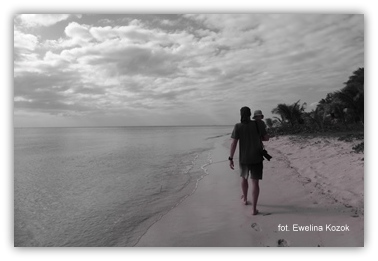
Bounty Island – Denarau 5pm - 5.30pm (30 minutes cruise)
That is an official schedule. In practice it's a bit different.
On the Awesome Adventures Fiji
website you can buy transport and accommodation, as well as packages. It seems to me that it's easier to book the accommodation with each resort separately, using their websites.
Motorboat pass for 5 days (4 nights) costs 440 F$ (183 €), 7 days (6 nights) 560 F$ (233 €), 10 days (9 nights) 735 F$ (306 €) etc. up to 21 days for 965 F$ (402 €).
In my case 5 day transport pass, full board and 4 nights, booking for three adults in one cottage at time, cost me 1060 F$ per person (443 €).
![]()
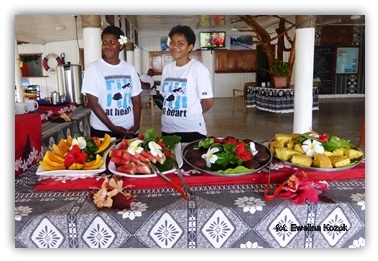 food – Main Island - close to 50% of the island population are the Hindus, so Indian cuisine is extremely popular here. There are also Chinese dishes. Local cuisine is also available, and these meals in cheap places costs 5-10 F$ (2-4 €). European food is available only at tourist spots and the price immediately doubles or triples.
food – Main Island - close to 50% of the island population are the Hindus, so Indian cuisine is extremely popular here. There are also Chinese dishes. Local cuisine is also available, and these meals in cheap places costs 5-10 F$ (2-4 €). European food is available only at tourist spots and the price immediately doubles or triples.
Yassawa and Mamanuca Islands – you mandatory have to buy a package accommodation/food/transport. My friends warned me that I’ll be hungry and have to stock up with instant soups and sweets. However, I brought back with me almost all my supplies. At islands resorts I was getting extra portions, so the food was good and in quality and quantity.
![]()
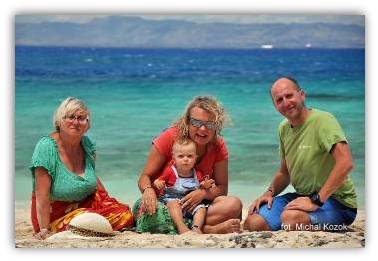 getting there – Fiji has a lot of flight connections with East Asia, Australia, New Zealand, and even with North America.
getting there – Fiji has a lot of flight connections with East Asia, Australia, New Zealand, and even with North America.
We booked a direct flight from Sydney, round trip cost 617 AUD (389 €), flight took around 4.5 hours.
weather – Fiji has dry season between April and October. Not only raining is acceptable in amount, but also the humidity and the temperatures are bearable. During the local summer here from November to March, there is also hurricane season. Although all resorts are open all year round.
 currency – Fijian dollar
currency – Fijian dollar
The currency exchange office/bank usually charges a commission 3 F$ (1.2 €). In the airport bank for the exchange of 50 AUD I got on hand 69.2 F$. ie the exchange rate 1 AUD = 1.44 F$. However, the ATM charges you fee 12 F$ (5 €), plus the bank charges a conversion fee. After counting all fees, I gained rate 1 AUD = 1.38 F$
So it seems that it is more profitable to exchange money in cash.
visa–
Most European Union citizens and other developed countries do not need visa to Fiji.